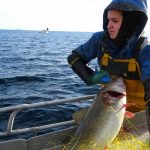Record shows that in 1939, California’s annual catch weighed in at 1.3 billion pounds. Since then, the fisheries off California’s coast have dramatically declined. In 2008 the catch was only 384 million pounds. Some species— most varieties of abalone, sardines and mackerel, for example — have experienced full collapse in recent years.
Expert believes that the state’s salmon fishery is on life support. And revenues from the Pacific groundfish trawl fishery that include soles and cod as well as deep-water “rockfish” like colorful canary and thorny heads fell by more than half from 1997 to 2007, from $47.3 million to $22.2 million along the West Coast.
Groundfish fishing used to be the backbone of California’s fishing ports, but now it is declining which have severely impacted fishing infrastructure as well as fishing jobs. In 2008, the Pacific Fishery Management Council unanimously voted to implement catch shares in the groundfish trawl fishery off the coast of California, Oregon and Washington. As the name implies, catch shares dedicate a percentage of the annual allowable catch to an individual fisherman, fishing cooperatives, or a community.
The federal government has given golden opportunity to the fishermen as it sets and enforces overall annual harvest limits, and fishermen are free to find the most profitable way to fish, up to their annual quotas. Catch shares have a proven track record for turning around declining fisheries.
Research study revealed that catch share management can halt and even reverse decades of decline in the world’s fisheries. A follow-up study in Nature shows that as fisheries recovered under catch share management, the sustainable harvest grew and, on average, quadrupled within a decade.








